Results 5,291 to 5,300 of 12094
Thread: Anandtech News
-
08-28-15, 02:35 PM #5291
Anandtech: The Intel Skylake i7-6700K Overclocking Performance Mini-Test to 4.8 GHz
At the time of our Skylake review of both the i7-6700K and the i5-6600K, due to the infancy of the platform and other constraints, we were unable to probe the performance uptake of the processors as they were overclocked. Our overclock testing showed that 4.6 GHz was a reasonable marker for our processors; however fast forward two weeks and that all seems to change as updates are released. With a new motherboard and the same liquid cooler, the same processor that performed 4.6 GHz gave 4.8 GHz with relative ease. In this mini-test, we tested our short-form CPU workload as well as integrated and discrete graphics at several frequencies to see where the real gains are.
More...
-
08-28-15, 03:30 PM #5292
Anandtech: AMD Quietly Releases Radeon R9 370X, China-Only For Now
Back in June when AMD launched the Radeon 300 series, AMD made the unusual move of only releasing refresh SKUs for around half of their products. While the 390 series saw the release of the vanilla 390 and 390X parts, the 380, 370, and 360 were all released with just one SKU respectively. Furthermore all three parts were the second-tier configurations for their respective GPUs, each packing a partially disabled GPU. At the time we suspected that AMD was simply holding back some SKUs to avoid flooding the market all at once and to release those SKUs at a more convenient opportunity, and it looks like this is indeed the case.
Alongside yesterday’s R9 Nano unveil, AMD also quietly launched the R9 370X. The unexpectedly quiet launch of the SKU is due to the fact that AMD is only releasing it on a regional basis, at least for the time being. As reported by PCWorld, who received confirmation from AMD, the R9 370X is only going to be available in China at this time.
The China-only launch of the R9 370X comes shortly after the launch of NVIDIA’s GeForce GTX 950, a card that we expect will be especially popular in China given pricing, economics, and the specific popularity of free-to-play games in that market. As a result, AMD releasing a China-only SKU, while not normal, is not without merit since it’s likely going to be China and the greater APAC region where the real fight over sales volume for this class of parts will be. Still, we also expect that R9 370X will eventually come to North America, similar to how AMD rolled out some of the 200 series SKUs.
As for the R9 370X itself, the SKU is the refresh successor to the R9 270X. This means we’re looking at a fully-enabled Pitcairn GPU with all 1280 stream processors enabled. This marks the fourth such desktop SKU for the full Pitcairn configuration, following the original Radeon HD 7870 and the R9 270 & 270X, both of the latter being fully enabled parts.AMD GPU Specification Comparison AMD Radeon R9 370X AMD Radeon R7 370 AMD Radeon R9 270X AMD Radeon HD 7870 Stream Processors 1280 1024 1280 1280 Texture Units 80 64 80 80 ROPs 32 32 32 32 Core Clock ? 925MHz 1000MHz 1000MHz Boost Clock ? 975MHz 1050MHz N/A Memory Clock 5.6Gbps GDDR5 5.6Gbps GDDR5 5.6Gbps GDDR5 4.8Gbps GDDR5 Memory Bus Width 256-bit 256-bit 256-bit 256-bit VRAM 2GB/4GB 2GB 2GB 2GB FP64 1/16 1/16 1/16 1/16 TrueAudio N N N N Transistor Count 2.8B 2.8B 2.8B 2.8B Typical Board Power ? 110W 180W 190W Manufacturing Process TSMC 28nm TSMC 28nm TSMC 28nm TSMC 28nm Architecture GCN 1.0 GCN 1.0 GCN 1.0 GCN 1.0 GPU Pitcairn Pitcairn Pitcairn Pitcairn Launch Date China-Only 06/18/15 10/08/13 03/05/12 Launch Price N/A $149 $199 $349
At this time we don’t have official AMD specifications for the R9 370X SKU (nor do we expect to get them). Furthermore based on information released by TechPowerUp, the first card released is a factory overclocked Sapphire model, so we have limited information available on clockspeeds. However based on the 5.6Gbps memory speed, it would appear that this is closer to a straight re-badge than was the case with the release of the 200 series, as AMD reworked their board designs to improve memory clockspeeds for that refresh.AMD Radeon Product Evolution Predecessor GPU Successor Radeon R9 290X Hawaii Radeon R9 390X Radeon R9 285 Tonga Radeon R9 380 Radeon R9 270/270X
Radeon HD 7870Pitcairn Radeon R9 370X Radeon R7 265
Radeon HD 7850Radeon R7 370 Radeon R9 260 Bonaire Radeon R9 360
In any case, while the R9 370X is China-only for the time being, don't be too surprised if we see it released in North America before too long, especially once R9 270 series supplies start dropping.
Sources: TechPowerUp & PCWorld
More...
-
08-28-15, 04:31 PM #5293
Anandtech: Razer Launches New Wildcat Xbox One Controller And New Version Of The Nabu
Today at PAX Razer announced a refresh of the Nabu smartband which they first announced at CES in 2014. They also announced that they will be selling the Razer Wildcat controller for the Xbox One, which is their third generation Razer Xbox controller.
First, the Nabu, which Razer dubs a Smartband. This wearable can track your steps, display notifications, and share with other Nabu bands. Razer has redesigned the band based on user feedback including moving the interaction button to make it more accessible. The OLED display is still a single color, low resolution, but the trade-off is up to six days of battery life. Razer is also promoting a new companion app for the Nabu and Nabu X (X has no display) with a new, cleaner UI than the outgoing app. Current Nabu X owners can get the app at www.razerzone.com/nabu-x starting today.
The new Nabu will be available for pre-order on September 15th for $99.99 USD, and shipping will be in October.
The next item announced is a new Xbox One controller from Razer. The Wildcat controller is labeled as tournament grade, and it includes quite a few tweaks to help give an edge. The controller itself is not going to get lost in a room, with some pretty distinct styling, but under the covers is a controller which Razer says is 20% lighter than other tournament grade controllers. It has four mult-function buttons added, and gamers can re-bind any button on the controller.
The analog stick is made of high carbon steel for durability, and the triggers are aircraft-grade aluminum. You can swap out the optional palm grips and analog stick grip caps. All in all, the Wildcat has the following features listed:
- 2 shoulder Hyperesponse Multi-Function bumpers
- 2 removable Hyperesponse Multi-Function triggers
- 4 Hyperesponse ABXY action buttons
- 4 button Quick Control Panel
- Optional trigger stops for rapid fire
- 3.5 mm audio port for stereo audio output and microphone input
- Optional rubber palm grips
- Optional analog stick grip caps
- Carrying case
- Detachable 3 m / 10 ft. lightweight braided fiber cable with Micro-USB connector
- Approximate size : 106 mm / 4.17 in. (Length) x 156 mm / 6.14 in. (Width) x 66 mm / 2.60 in. (Height)
- Approximate weight (without cable) : 260 g / 0.57 lbs
The Wildcat controller will be available starting in October for $149.99
Source: Razer
More...
-
08-30-15, 06:30 PM #5294
Anandtech: NVIDIA Announces GRID 2.0, Tesla M60 & M6 Server Cards
Kicking off this week in San Francisco is VMware’s annual VMworld conference. One of the major yearly virtualization conferences, it’s also host to a number of virtualization-related product announcements. And this year NVIDIA is wasting no time in making their announcements, releasing their major GRID news alongside this afternoon’s welcome reception.
To that end, today NVIDIA is announcing the next generation of their Virtual Desktop Infrastructure (VDI) GPU technology, GRID 2.0. This is the first full-point update of their VDI technology since the company launched GRID 1.0 back in 2012, and comes as GRID 1.x vGPU capabilities are finally widely available in the latest versions of VMware’s and Citrix’s respective hypervisors. GRID 2.0 in turn builds off of what NVIDIA has accomplished so far with GRID, further expanding the number of concurrent users and performance of GRID while also introducing some new features that didn’t make the cut for GRID 1.0.
Furthermore, launching alongside GRID 2.0 are new Maxwell based Tesla cards. While the launch of these cards is something of a low-key event – NVIDIA is opting to focus on GRID as opposed to the hardware – some of the new GRID 2.0 functionality goes hand-in-hand with the new hardware, so this is where we’ll start.
Tesla M60 & Tesla M6
When NVIDIA launched the first version of the GRID (née VGX) ecosystem in 2012, they launched a pair of cards alongside it, the K1 and K2. Based around NVIDIA’s Kepler GK107 and GK104 GPUs respectively, these cards have been the backbone of GRID for the last three years. However with NVIDIA launching their Maxwell architecture in 2014 it was only a matter of time until these cards were replaced with their higher performing successors, and that time is now.
Launching for GRID 2.0 are the Tesla M60 and Tesla M6. In a departure from the GRID K series, both of the Tesla M series cards are based on the same GPU, NVIDIA’s GM204. The difference between the two cards is now the number of GPUs on a card and the overall form factor.NVIDIA Tesla/GRID GPU Specification Comparison Tesla M60 Tesla M6 GRID K2 GRID K1 CUDA Cores 4096
(2x 2048)1536 3072
(2x 1536)768
(4x 192)VRAM 16GB GDDR5
(2x 8GB)8GB GDDR5 8GB GDDR5
(2x 4GB)16GB DDR3
(4x 4GB)Concurrent Users 2-32 1-16 ? ? H.264 1080p30 Streams 36 18 ? ? Form Factor Dual Slot PCIe MXM Dual Slot PCIe Dual Slot PCIe TDP 225W-300W 75W-100W 225W 130W GPU 2x GM204 GM204 2x GK104 4x GK107
The larger of the two cards, Tesla M60, is a dual-GM204 solution featuring two fully enabled GM204 GPUs and 16GB of GDDR5 (8GB per GPU). The M60 is a full size, dual slot card similar to the previous generation GRID cards, and is rated for between 225W and 300W depending on the performance and cooling configuration (both passive and active are available). NVIDIA has rated the M60 for up to 32 concurrent vGPU users, or 16 users per GM204 GPU. Notably this is also the first time we’ve seen a dual GM204 card, as one was never released in the consumer market.
Meanwhile the Tesla M6 marks a new form factor for an NVIDIA GRID or Tesla product, coming in an MXM form factor. This card packs a single, partially enabled GM204 GPU with 12 of 16 SMXes (1536 CUDA cores) enabled, paired with 8GB of GDDR5. With only a single GPU it’s essentially rated for half as much work as M60, topping out at 16 users. However in turn it only draws 75W to 100W of power depending on configuration, and more importantly the MXM form factor makes the card suitable for installation in high-density blade servers, something that could not be done with the PCIe cards. Otherwise the card’s specifications are very similar to NVIDIA’s consumer GeForce GTX 980M, and we wouldn’t be surprised if this was the GTX 980M repurposed for server use.
Since the hardware is not the focus of today’s announcement NVIDIA isn’t releasing much more in the way of information, but there are two quick points we want to touch on. First, the company is also rating these cards by the number of 1080p30 H.264 streams they can encode, presumably for the video encoder market. The Tesla M60 is rated for 36 streams and the Tesla M6 for 18 streams. Second of all, these cards are being released under the Tesla brand and not the GRID brand. Tesla has previously been reserved for pure compute cards (e.g. Tesla K80), but since VDI is just another GPU application at this point – i.e. there are no appreciable hardware differences between a VDI card and a pure compute card – NVIDIA would appear to be converging all of their server cards under the Tesla brand.
GRID 2.0
Getting back to NVIDIA’s principle announcement then, let’s talk about GRID 2.0. The release of the Tesla cards means that GRID 2.0 offers a slew of performance and density features over GRID 1.0 thanks to the newer hardware. From a performance standpoint NVIDIA is advertising the new Tesla cards as offering 2x the performance of their GRID K-series cards, allowing for either per-user performance to be doubled, or for the number of concurrent users to be doubled. The performance argument is essentially about improving performance at the high-end where GPUs are already allocated on a 1:1 basis, meanwhile improving concurrent user counts ultimately brings down the number of cards required, and thereby the overall cost of servers to support a VDI operation.
The fact that NVIDIA now has MXM form factor cards for blade servers also plays a role here, as it improves on the physical density of VDI hosting. Blade servers offer tremendous hardware density, and bringing a VDI capable GPU into that environment allows for similar improvements in GPU-accelerated VDI density.
Meanwhile alongside the hardware-borne improvements, GRID 2.0 also brings new functionality to the GRID ecosystem for current GRID K-series users. NVIDIA tells us that the new software supports twice the number of concurrent users as GRID 1.0, raising the limit to 128 users per server. And while performance will scale down accordingly, it will allow for greater user density with very light workloads.
More significant for current GRID users, I suspect, will be that GRID vGPU environments now support CUDA. Previously CUDA support was not available within the vGPU, requiring a 1:1 (pass-through) environment to access it. NVIDIA has been pushing hard for over the last half-decade to get GPU compute acceleration (via CUDA) inside professional software packages, and a lack of CUDA vGPU support meant that those programs couldn’t be fully accelerated within a vGPU environment. This change improves that situation, essentially allowing for CUDA users to finally be fully virtualized and run concurrently with each other on a single GPU. However it should be noted that there are some limitations here, with NVIDIA noting that CUDA vGPU support requires using the GRID 2.0 “8GB profile.”
GRID 2.0 also improves on guest OS support for multiple operating systems. New to GRID 2.0, NVIDIA now supports Linux guests, joining the company’s existing Windows support. On the subject of Linux use cases NVIDIA specifically mentions oil & gas users, so we suspect that this is as much for compute/CUDA users as it is for graphical users. Meanwhile GRID 2.0 also introduces formal support for Windows 10 on a “tech preview” basis, allowing Microsoft’s latest OS to be virtualized while retaining the full functionality of GRID.
Last, GRID 2.0 also introduces support for 4K monitors. Previously GRID’s maximum resolution was WQXGA (2560x1600), so this lifts the limit to support newer, higher resolution monitors. Overall the new limit for GRID 2.0 is four 4K monitors per VM.
Wrapping things up, while today’s reveal is the first public announcement of GRID 2.0, NVIDIA will be keeping the gap between announcement and release very short. GRID 2.0 is already in testing at a dozen companies, NVIDIA tells us, and the final version will be released to customers at large on September 15th.
More...
-
08-31-15, 07:01 AM #5295
Anandtech: Corsair Flash Voyager GS USB 3.0 512GB Flash Drive Capsule Review
The ubiquity of USB 3.0 as a high speed interface for PCs and the increasing affordability of flash memory has led to some very interesting products. USB flash drives are a dime a dozen, but there is scope for manufacturers to differentiate themselves. High-performance flash drives have traditionally employed a SATA SSD controller behind a USB 3.0 - SATA bridge. However, this increases the drive cost in what is essentially a price-sensitive market. Controller vendors have recently started to introduce native high-performance USB 3.0 flash controllers. Today, we look at two products from the Corsair stable - the Flash Voyager GTX and the Flash Voyager GS. While the GTX is the high performance play (topping out at 256GB), the GS is more of a capacity play (the top end version has 512GB of flash memory).
Corsair is one of the very few vendors to have a 512GB thumb drive in their product portfolio. In fact, the only other vendor with a 512GB flash drive is Kingston (I am not considering SSDs in an external enclosure like the Samsung Portable T1). This makes the Flash Voyager GS one of the unique products in the market right now. Users looking at the currently available Flash Voyager GTX will find that the same casing is used for the Flash Voyager GS also. The Flash Voyager GTX 256GB was one of the earliest flash drives that we evaluated with the new methodology. Since then, Corsair has changed the casing while retaining the same internals and model name / number. In addition to evaluating the performance of the Voyager GS, we will also be looking at the new Voyager GTX (referred to as Voyager GTX v2 hereon).
Hardware Design and Internals
The housings of both the Corsair Flash Voyager GS and GTX are made of a zinc alloy with aluminium accents. There is a small loop at one end for attaching to a keyring. An activity LED is also near the loop. While the previous generation Corsair Voyager GTX's external design was not as stylish, it at least allowed the protective cap to be securely placed at the other end during active usage. This is not possible in the current housing design. The photographs below show the Corsair Voyager GS and GTX v2 as well as the the old and new Voyager GTX versions side by side.
We already know from our previous review that the Voyager GTX comes with the Phison S9 SSD controller behind a USB 3.0 - SATA bridge. The Voyager GS is a native USB 3.0 flash drive, and the internals (Phison PS2251-01 with Toshiba MLC flash) could be determined without looking at the unit.
Testbed Setup and Testing Methodology
Evaluation of DAS units on Windows is done with the testbed outlined in the table below. For devices with USB 3.0 connections (such as the Corsair Voyager GS and GTX that we are considering today), we utilize the USB 3.0 port directly hanging off the PCH.
The full details of the reasoning behind choosing the above build components can be found here. The list of DAS units used for comparison purposes is provided below.AnandTech DAS Testbed Configuration Motherboard Asus Z97-PRO Wi-Fi ac ATX CPU Intel Core i7-4790 Memory Corsair Vengeance Pro CMY32GX3M4A2133C11
32 GB (4x 8GB)
DDR3-2133 @ 11-11-11-27OS Drive Seagate 600 Pro 400 GB Optical Drive Asus BW-16D1HT 16x Blu-ray Write (w/ M-Disc Support) Add-on Card Asus Thunderbolt EX II Chassis Corsair Air 540 PSU Corsair AX760i 760 W OS Windows 8.1 Pro Thanks to Asus and Corsair for the build components
- Corsair Voyager GS 512GB
- Corsair Voyager GTX v2 256GB
- Corsair Voyager GTX 256GB
- LaCie Rugged Thunderbolt 500GB
- Patriot Supersonic Rage 2 256GB
- VisionTek Pocket SSD 240GB
Synthetic Benchmarks - ATTO and Crystal DiskMark
Corsair claims read and write speeds of around 290 MBps for the Voyager GS. ATTO reports only around 160 MBps for writes and 270 MBps for reads with our standard test settings. For the GTX v2, the results are in the same ballpark as that of the original GTX (around 375 MBps writes and 460 MBps reads).
Corsair Voyager GS 512GBCorsair Voyager GTX v2 256GBCorsair Voyager GTX 256GBLaCie Rugged Thunderbolt 500GBPatriot Supersonic Rage 2 256GBVisionTek Pocket SSD 240GBCrystalDiskMark, despite being a canned benchmark, provides a better estimate of the performance range with a selected set of numbers. These numbers seem to back up Corsair's performance claims. As evident from the screenshot below, the performance can dip to as low as 0.8 MBps for 4K random accesses at low queue depths for the Voyager GS. For the GTX v2 / GTX, these tests show around 400 MBps reads and 180 MBps writes - the two versions don't differ much in the artificial benchmarks, as expected.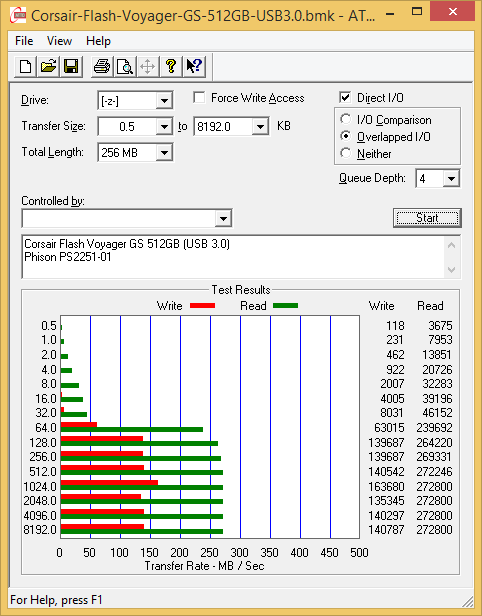
Corsair Voyager GS 512GBCorsair Voyager GTX v2 256GBCorsair Voyager GTX 256GBLaCie Rugged Thunderbolt 500GBPatriot Supersonic Rage 2 256GBVisionTek Pocket SSD 240GBBenchmarks - robocopy and PCMark 8 Storage Bench
Our testing methodology for DAS units also takes into consideration the usual use-case for such devices. The most common usage scenario is transfer of large amounts of photos and videos to and from the unit. The minor usage scenario is importing files directly off the DAS into a multimedia editing program such as Adobe Photoshop.
In order to tackle the first use-case, we created three test folders with the following characteristics:
- Photos: 15.6 GB collection of 4320 photos (RAW as well as JPEGs) in 61 sub-folders
- Videos: 16.1 GB collection of 244 videos (MP4 as well as MOVs) in 6 sub-folders
- BR: 10.7 GB Blu-ray folder structure of the IDT Benchmark Blu-ray (the same that we use in our robocopy tests for NAS systems)





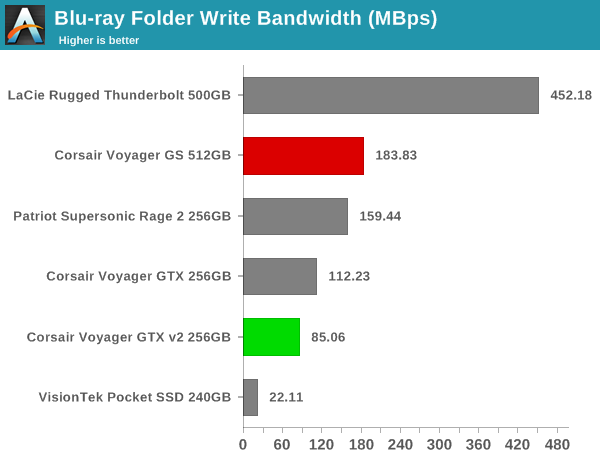
For the second use-case, we take advantage of PC Mark 8's storage bench. The storage workload involves games as well as multimedia editing applications. The command line version allows us to cherry-pick storage traces to run on a target drive. We chose the following traces.
- Adobe Photoshop (Light)
- Adobe Photoshop (Heavy)
- Adobe After Effects
- Adobe Illustrator
Usually, PC Mark 8 reports time to complete the trace, but the detailed log report has the read and write bandwidth figures which we present in our performance graphs. Note that the bandwidth number reported in the results don't involve idle time compression. Results might appear low, but that is part of the workload characteristic. Note that the same testbed is being used for all DAS units. Therefore, comparing the numbers for each trace should be possible across different DAS units.


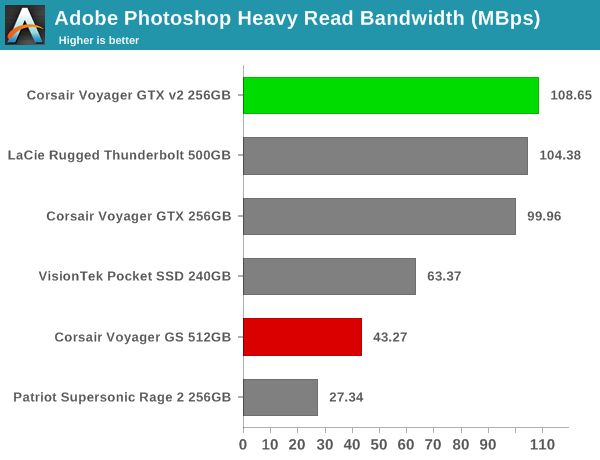

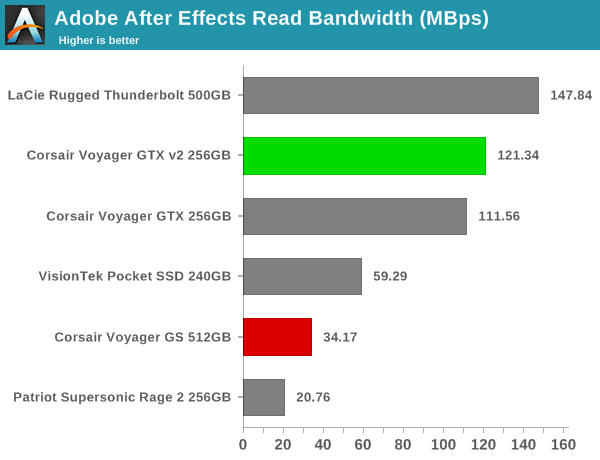
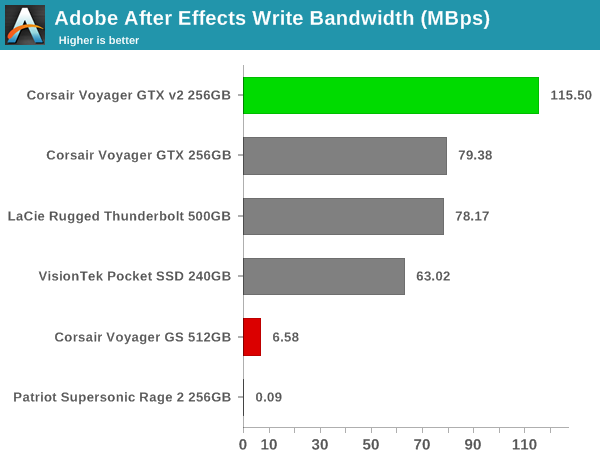
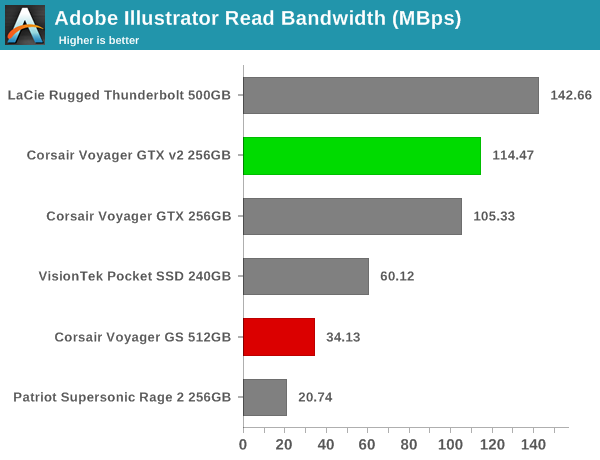

Performance Consistency
Yet another interesting aspect of these types of units is performance consistency. Aspects that may influence this include thermal throttling and firmware caps on access rates to avoid overheating or other similar scenarios. This aspect is an important one, as the last thing that users want to see when copying over, say, 100 GB of data to the flash drive, is the transfer rate going to USB 2.0 speeds. In order to identify whether the drive under test suffers from this problem, we instrumented our robocopy DAS benchmark suite to record the flash drive's read and write transfer rates while the robocopy process took place in the background. For supported drives, we also recorded the internal temperature of the drive during the process. The graphs below show the speeds observed during our real-world DAS suite processing. The first three sets of writes and reads correspond to the photos suite. A small gap (for the transfer of the videos suite from the primary drive to the RAM drive) is followed by three sets for the next data set. Another small RAM-drive transfer gap is followed by three sets for the Blu-ray folder.
An important point to note here is that each of the first three blue and green areas correspond to 15.6 GB of writes and reads respectively. Throttling, if any, is apparent within the processing of the photos suite itself. The Corsair Voyager GS and the new GTX don't suffer from any such issues.
Corsair Voyager GS 512GBCorsair Voyager GTX v2 256GBCorsair Voyager GTX 256GBLaCie Rugged Thunderbolt 500GBPatriot Supersonic Rage 2 256GBVisionTek Pocket SSD 240GBThe surprising results in the above graphs involve the GTX v2 and GTX. While the original GTX took around 1900s to finish the benchmark, the GTX v2 took around 2200s. The reason behind this is evident in the robocopy benchmarks also - the write speeds of the new GTX seem to be a tad lower compared to the original GTX even though CrystalDiskMark and ATTO seem to indicate that both should have comparable performance. Corsair assured us that nothing had changed internally, but we did see that our original results were with firmware version S9FM01.7, while the GTX v2 came with S9FM02B1. Corsair indicated that S9FM02B1 is the best firmware to use for both the GTX and GTXv2.
Concluding Remarks
Coming to the business end of the review, the Corsair Voyager GS continues Corsair's leadership in the USB flash drive area. With a 512GB capacity, the Voyager GS is one of only two high capacity thumb drives available in the market. We have already talked about the GTX, and, as mentioned before, the availability of a real SSD controller in the form of the Phison S9 makes it one of the drives we would recommend for portable OS installations.
The Corsair Voyager GS doesn't support TRIM or any SMART commands. The Voyager GTX, on the other hand, supports both. Corsair's SSD Toolbox removed support for the Voyager GTX sometime last year. However, with 1.2.3.5 (released last week), support for the thumb drive is back. The SSD toolbox allows setting of software overprovisioning on the drive, something important to ensure performance consistency when used as a portable OS drive.
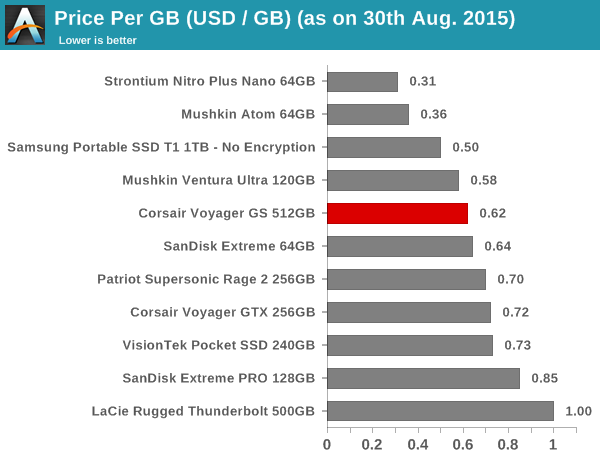
In terms of pricing, the Voyager GS 512GB retails for $315, while the GTX v2 256GB comes in at $185. These come in the middle of the pack in the price per GB graph above. As discussed earlier in this section, the GS and GTX v2 have different claims to uniqueness as justification for the slight pricing premium.
More...
-
08-31-15, 07:31 AM #5296
Anandtech: The ASUS ZenPad S (Z580CA) Review
When I think of ASUS and Android, the first thing that comes to mind is their past portfolio of Android tablets. ASUS has been making Android tablets since the first wave of Android Honeycomb tablets hit the market. Back then, ASUS's point of differentiation from all the other Android tablets with essentially the same Tegra 2 hardware platform was their attachable keyboard dock. One could argue that ASUS really pioneered the 2-in-1 tablet form factor with their Transformer tablets. While ASUS continued to release a number of additional Transformer tablets with updated specifications for some time, it has been a while since we've seen any new high end tablets from the company. Recent offerings have usually been more budget oriented devices like the MeMO Pad series, or the hard to find ASUS PadFone, with the spot for a more standard tablet being left unfilled.
Today's review takes a look at a tablet that doesn't pick up where the Transformer series left off, but instead kicks off a new line of tablets from ASUS under the ZenPad brand. There are a few different ZenPad tablets on the market, with multiple SKUs for each product creating even more versions. The tablet I'm looking at today is the ASUS ZenPad S, and more specifically, the ZenPad S Z580CA, which is ASUS's most high end tablet offering. To find out everything you need to know about ASUS's flagship tablet read on for the full review.
More...
-
08-31-15, 11:30 AM #5297
Anandtech: Google Announces Android Wear For iOS
Today Google announced that Android Wear now works with iPhones in addition to Android devices. The expansion to iPhones has been long rumored for the Android Wear platform, which up until now has only worked with Android smartphones.
Using an Android Wear watch with an iPhone is fairly simple. If you own an Android Wear watch which supports iOS, you can just navigate to the Bluetooth section of the iOS settings application and pair your watch to your iPhone. Because Bluetooth 4.0 is required, Android Wear watches will only work with the iPhone 5 and above, not unlike the Apple Watch. You'll also need to be running iOS 8.2 or newer.
Once you pair your watch with your iPhone, you'll be able to receive notifications, make and monitor fitness goals, and receive relevant information from Google Now. You can also use the "OK Google" command to make voice searches, which is something that iOS itself has never had throughout the OS due to the limitations of iOS applications.
As of right now, Android Wear for iOS only works on the LG Watch Urbane. According to Google, all future Android Wear devices will support iOS. The wording of Google's post indicates that iOS support won't be coming to other existing Android Wear devices, which would be very disappointing if true. More information about this new development for Android Wear can be found in Google's blog post in the source below.
More...
-
08-31-15, 01:30 PM #5298
Anandtech: The AnandTech Podcast: Episode 35 - Windows 10 and Skylake
AnandTech Podcast #35: The summer season has been busier than usual. Microsoft released Windows 10, it’s latest operating system, as a free upgrade to current Windows 7 and Windows 8 users, promising it to be the latest and greatest from Microsoft, but also why it might be the last full release of an operating system from them. Brett’s indepth review of Windows 10’s features is now available on the AnandTech website, with a link below. Hot on the heels of Windows 10 was Intel’s launch of its new Skylake processor microarchitecture, which came in two desktop processors only to begin with. This was followed up by a more in-depth discussion of what Skylake actually does at Intel’s Developer Forum, and in this podcast we discuss what Skylake brings to the table as well as the performance and our interpretation of how Intel’s vision is set to develop in the coming years.
The AnandTech Podcast - Episode 35
Featuring
- Dr Ian Cutress, Host, Senior Editor (@IanCutress)
- Brett House, Editor for Laptops (@BrettHowse)
iTunes
RSS - mp3, m4a
Direct Links - mp3, m4a
Total Time: 1 hour 49 minutes 25 seconds
Outline mm:ss
0:00 - Intro
0:20 - Microsoft Windows 10 (http://anandtech.com/show/9543)
2:50 - Free Upgrade and install base
10:00 - Windows Media Center removed
13:30 - Windows 10 First Use, Start Menu
15:00 - Windows as a Service
21:00 - Universal Windows Apps and the Windows Store
25:20 - Privacy Concerns
30:00 - Family Safety
33:30 - WDDM 2.0 and DirectX 12
44:30 - Intel’s 6th Generation Processor, Skylake (http://anandtech.com/show/9483)
47:00 - Skylake performance compared to previous generations
53:10 - What processors were launched
55:00 - Gaming Performance
58:10 - Z170 Chipset
1:03:00 - USB 3.1 ports from chipset
1:04:30 - Windows 7 support with Z170
1:07:30 - DDR4 Support
1:12:40 - Gen 9 GPU, Media Capabilities (http://www.anandtech.com/show/9562/)
1:19:20 - Overclocking
1:25:25 - Skylake Packaging and thermal compound (http://www.anandtech.com/show/9505/)
1:27:30 - Overclocking and iGPU ramifications
1:30:30 - Architecture
1:39:10 - eDRAM changes
1:42:00 - Mobile Parts - Where are Skylake Y/U/H?
1:43:00 - Skylake Xeon Mobile
1:45:40 - Kaby Lake (http://www.anandtech.com/show/9447/)
1:49:25 - FIN
More...
-
08-31-15, 06:00 PM #5299
Anandtech: Samsung Announces The Gear S2 Smartwatch
Today Samsung announced the Gear S2 and Gear S2 Classic, the newest products in their line of smartwatches. The Gear S2 has what Samsung describes as a more minimal and modern design, while the Gear S2 classic uses leather and a black finish in an attempt to appeal to fans of traditional mechanical watches.
In addition to WiFi versions, there's also the Gear S2 3G which includes cellular capabilities to allow the user to make phone calls from their watch. All three models of the Gear S2 are similar, but there are some differences to accommodate visual changes between the Gear S2 and Gear S2 classic, as well as to fit a larger battery in the 3G edition. I've laid out all the known specifications of the Gear S2 in the chart below.
The Gear S2 is powered by an unnamed dual core SoC with a peak frequency of 1GHz. The circular display has a maximum horizontal and vertical resolution of 360 pixels, which equates to 302 pixels per inch. With Tizen being Samsung's own operating system they can tune the interface to work best with their AMOLED displays to minimize power consumption. Both WiFi versions of the Gear S2 include a 250mAh battery, while the 3G edition increases this to 300mAh, with a corresponding increase in case thickness. According to Samsung, the WiFi only version of the Gear S2 will last between two and three days of typical usage, while the 3G model will last around two days.Samsung Gear S2 and Gear S2 Classic Samsung Gear S2 3G SoC 1.0GHz Dual Core CPU RAM/NAND 512MB RAM, 4GB NAND Display 1.2" Circular 360x360 SAMOLED (302ppi) Dimensions Gear S2: 42.3x49.8x11.4mm (47g)
Classic: 39.9x43.6x11.4mm (42g)44.0 x 51.8 x 13.4mm (51g) Battery 250 mAh (0.95 Whr) 300 mAh (1.14 Whr) OS Samsung Tizen Sensors Accelerometer, Gyroscope, Heart Rate, Ambient Light, Barometer Connectivity 802.11/b/g/n + BT 4.1, NFC
The Gear S2 also includes a number of sensors in order to track information pertaining to exercise and fitness. It includes an accelerometer, a gyroscope, a heart rate tracker, an ambient light sensor, and interestingly, a barometer which can be used for tracking elevation by measuring atmospheric pressure. A barometer is a sensor that was notably absent from the Apple Watch, and it could help give Samsung an edge when it comes to the accuracy of their health tracking.
Notably absent from the 3G model is a SIM slot. This is because the Gear S2 makes use of an e-SIM card, an embedded version of the SIM chip current devices use to register and work on mobile networks. It's not clear what implications this will have for carrier compatibility, but it would make sense that support from a carrier would be required in order to use the Gear S2 3G on their network.
Something that differentiates the Gear S2 from Samsung's previous watches are the methods of input that Samsung has included. The bezel around the circular display acts as a rotating input, which the user can use to zoom, scroll, etc. There are also two buttons located next to each other on the right side of the case, which function as home and back buttons respectively. This is again an advantage of Samsung using their own operating system, as they can implement controls that may not work within the control scheme of another operating system like Android Wear.
Naturally, Samsung's Tizen smartwatches don't have access to the application library or functionality that comes with Android Wear. However, a look at Samsung's history with smartwatches makes it clear that they are pushing Tizen as their major wearable platform for their devices rather than Android Wear. It will be interesting to see how this turns out for them. On one hand, they can tune the OS to work seamlessly alongside the hardware. On the other hand, they're limited in terms of third party support from app developers.
The Gear S2, Gear S2 Classic, and Gear S2 3G will be launching in the near future. There's currently no word on pricing, but there is already a commitment from AT&T, Verizon, and T-Mobile USA to sell the 3G version of the watch.
More...
-
08-31-15, 06:00 PM #5300
Anandtech: Netgear Launches XS728T 28-port 10-Gigabit Smart Managed Switch
In early 2013, Netgear launched the XS708E (8x 10GBASE-T with 1x shared 10G SFP+) unmanaged switch, the XS712T (12x 10GBASE-T with 2x shared 10G SFP+) smart managed switch and the XSM7224 (24x 10GBASE-T with 4x 10G SFP+) fully managed switch. Netgear is announcing the XS728T today, adding a new member to the smart managed switch family. The XS728T comes with 24x 10GBASE-T ports and 4x dedicated 10G SFP+ ports.
Netgear claims that the ProSafe XS728T is the industry's first 28-port 10-Gigabit Smart Managed Switch. It falls in the same category as the XS712T with respect to the management capabilities. We have been having a good experience using the XS712T in our 10G-capable NAS testbed. It is not a fully managed switch, but does manage to be cost-effective in the process.
Compared to the XS712T, the XS728T brings support static IPv6 routing. Netgear advertises L2+/Layer 3 Lite features in the XS-T series making them suitable for core switches in SMB environments. The datasheet provides information about the L2+ / L3 Lite features.
The performance aspects of the XS712T and the XS728T are summarized in the table below.
The datasheet provides detailed technical specifications. One of the aspects that caught my eye was the acoustic levels. While the XS712T was rated at 49.7 dBA (We use it in our testbed, and the noise is pretty much what makes the usage of the unit difficult during evaluation in a home lab setting), the XS728T comes in at 41.6 dBA. I was also curious about the core platform. Netgear indicated that the XS728T uses Marvell silicon inside. These are fabricated in a smaller process node (we believe it is the Alaska transceivers and some combination of Prestera DX packet processors fabricated in 28nm). These operate a bit cooler, reducing the thermal load. The number of fans in the XS728T has also been doubled to four (compared to two in the XS712T). Taken together, these changes have enabled Netgear to run the fans slower and generate less noise.
The XS728T has a MSRP of $4624. However, as is usual with enterprise equipment, final pricing for end customers may vary from one reseller to another.
More...
Thread Information
Users Browsing this Thread
There are currently 11 users browsing this thread. (0 members and 11 guests)





 Quote
Quote
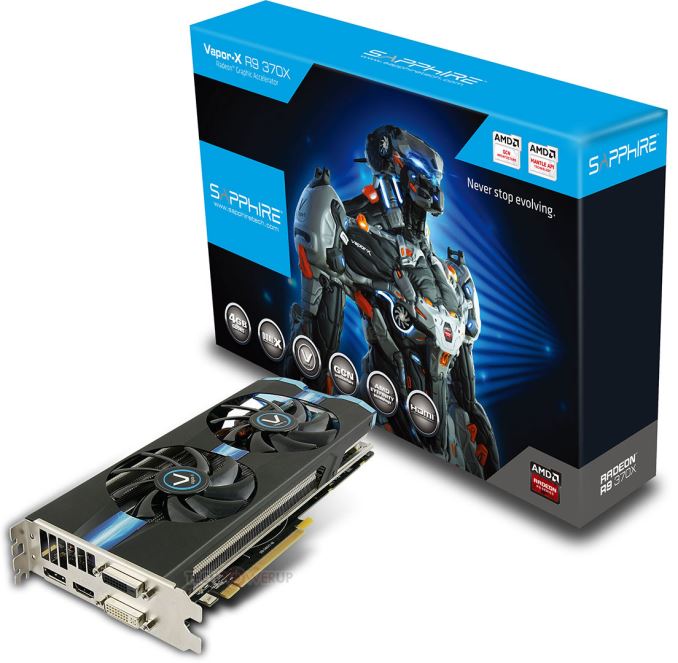
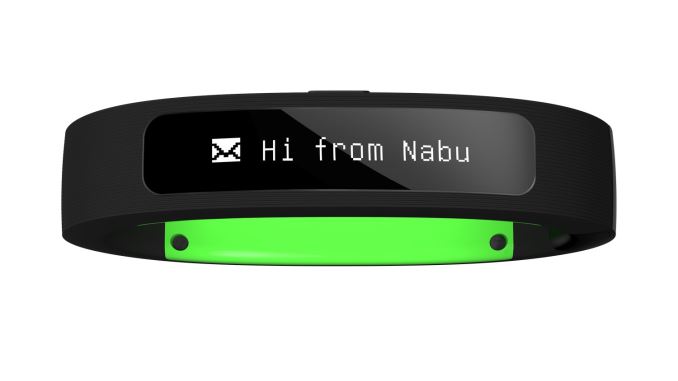





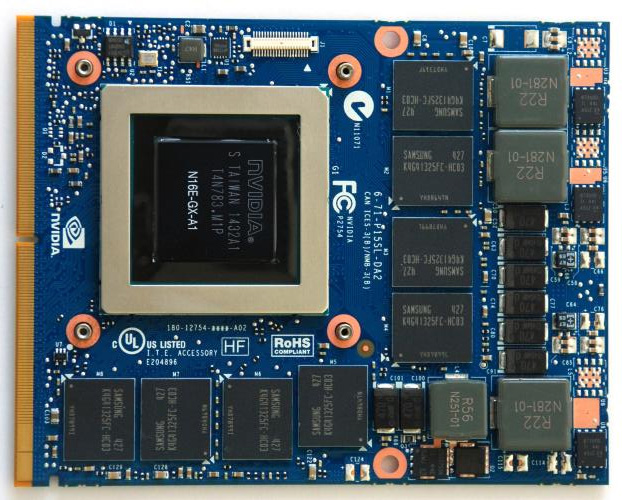
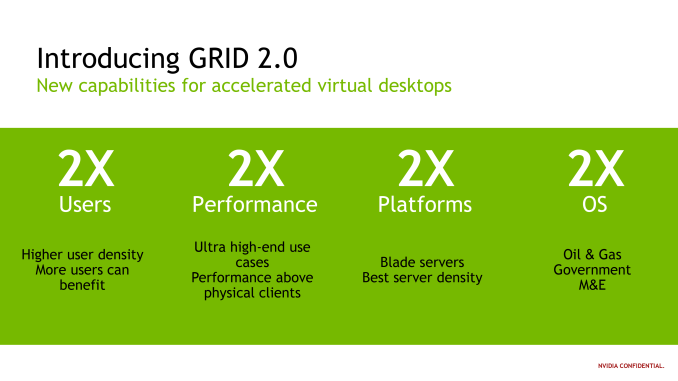
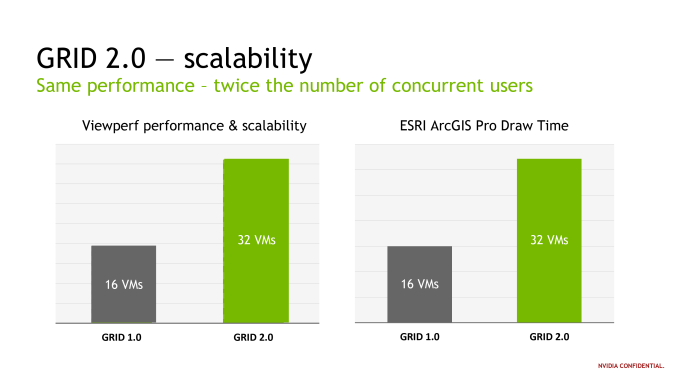
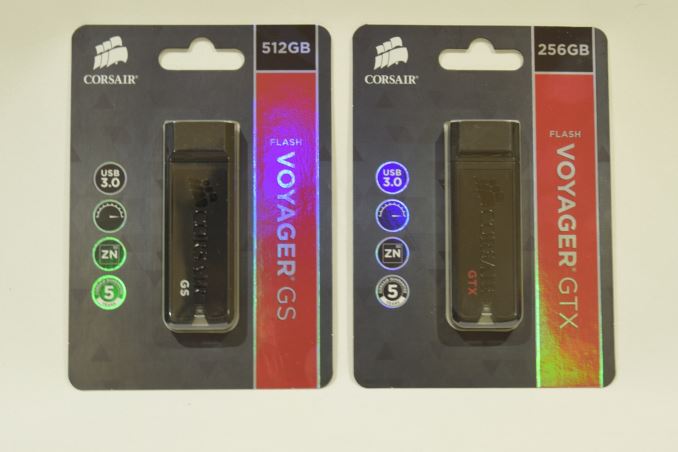
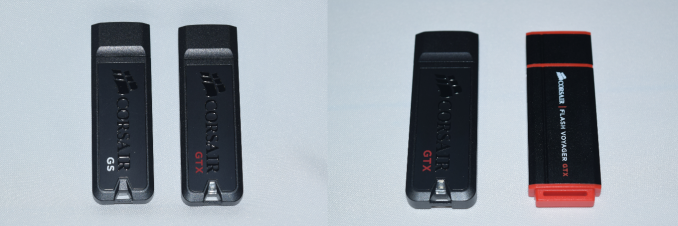
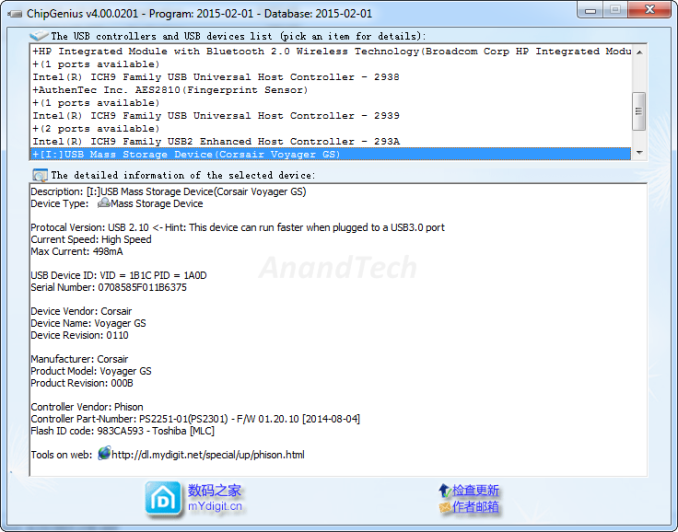

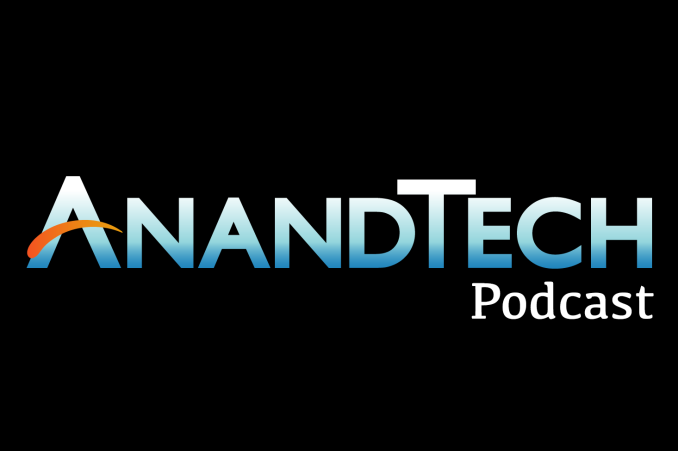
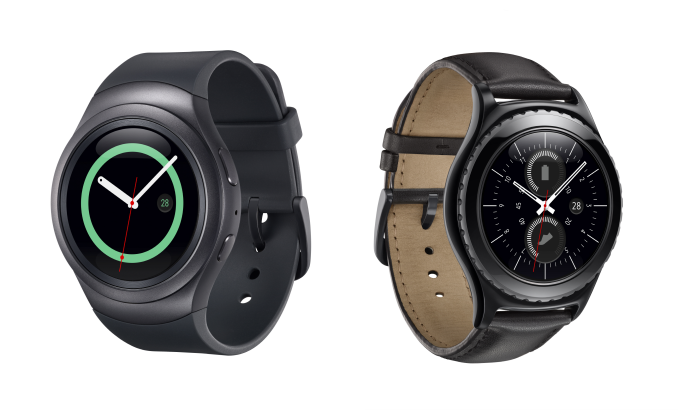
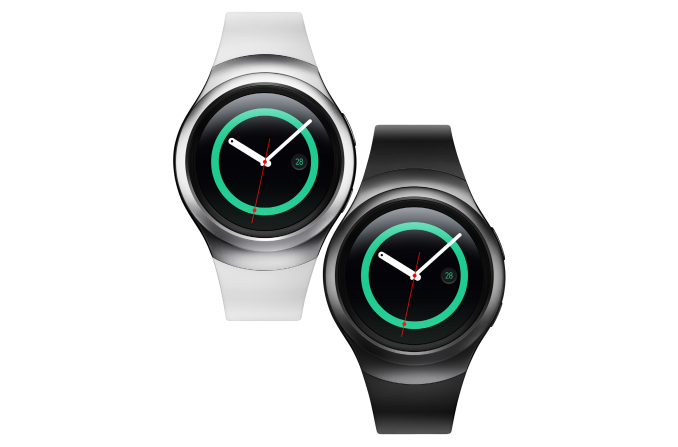



















Bookmarks